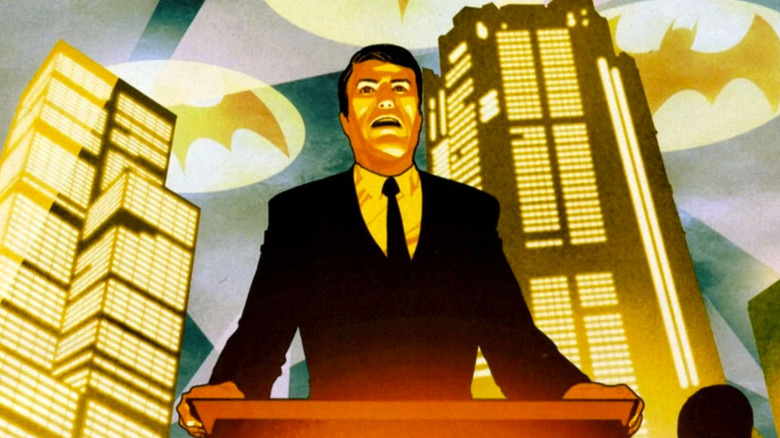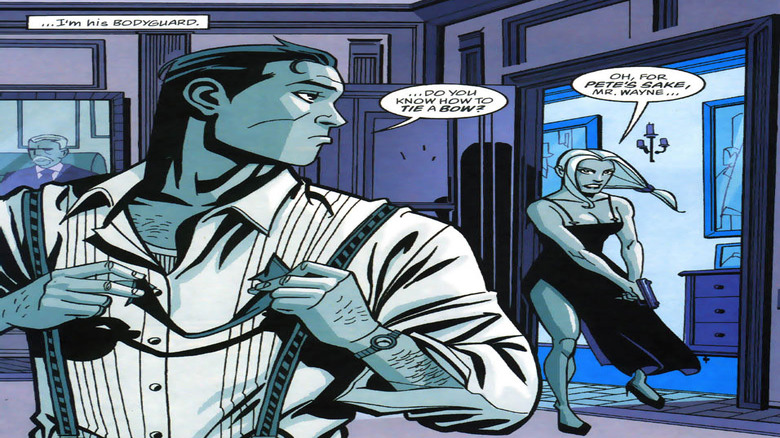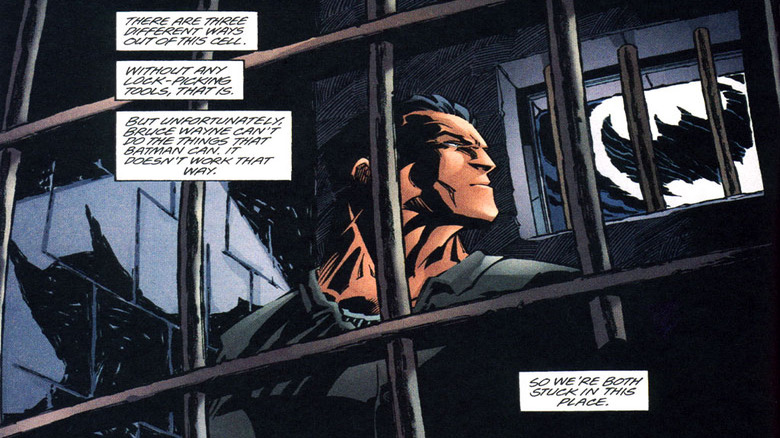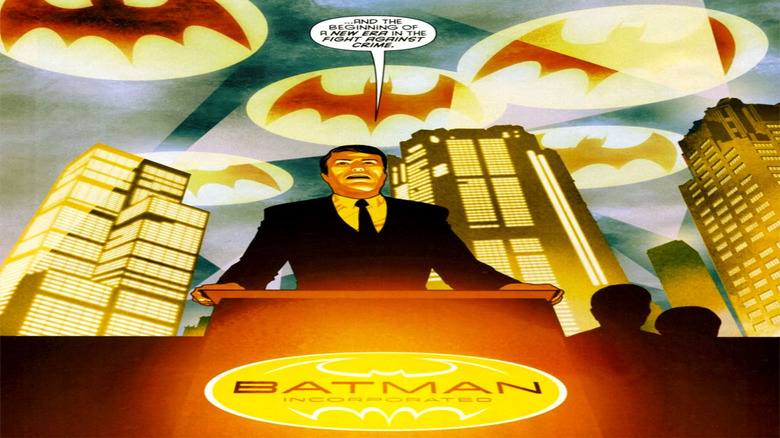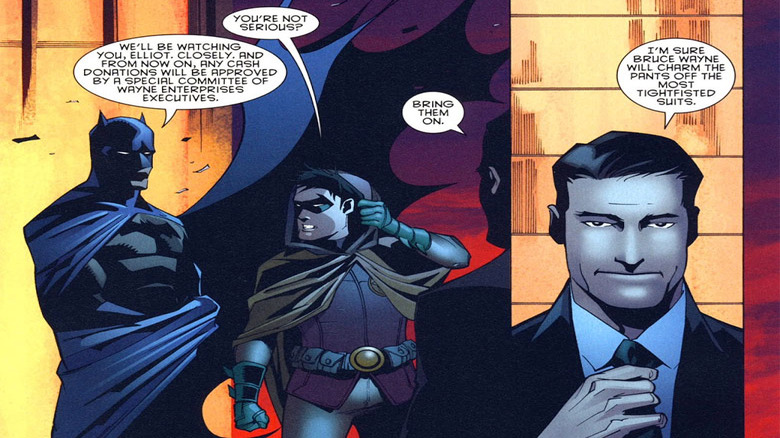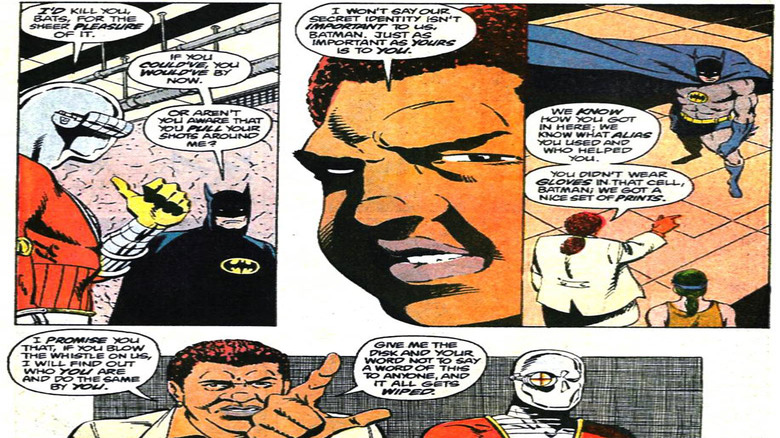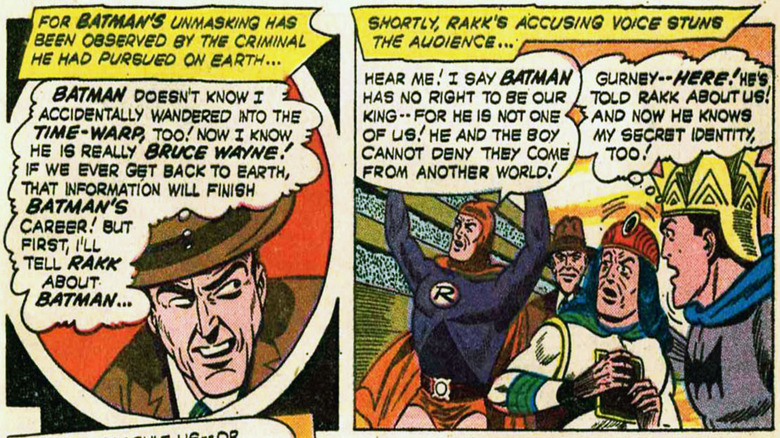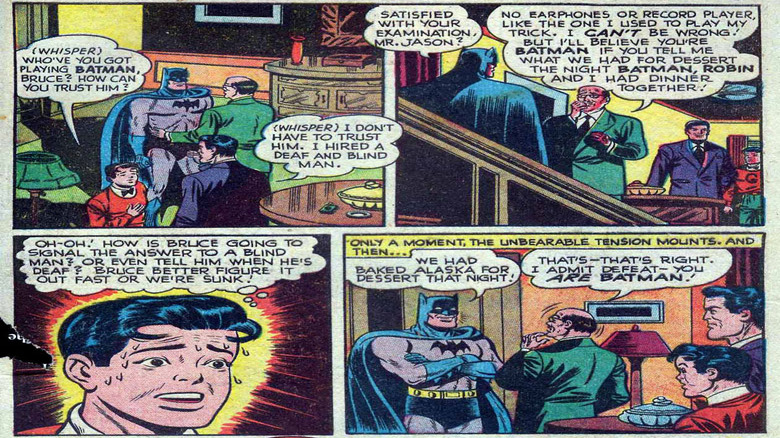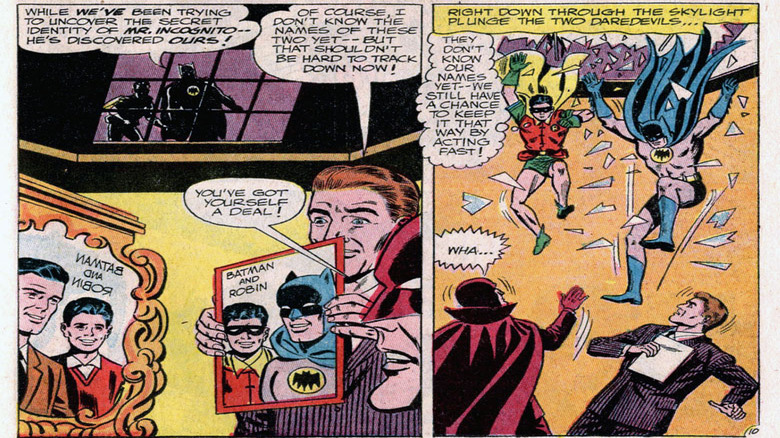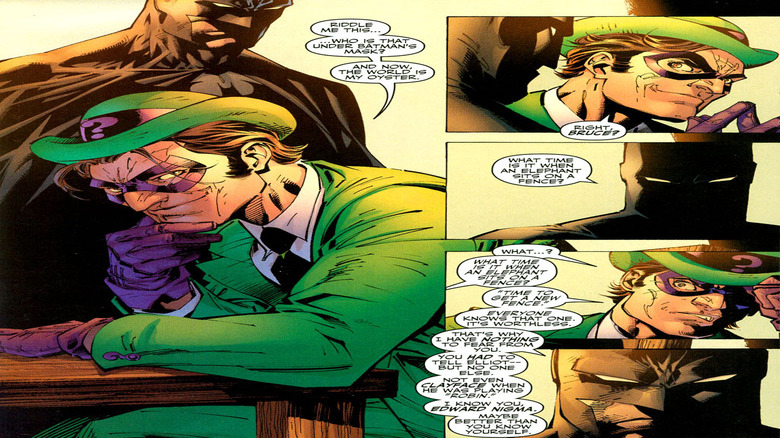Most Bizarre Things Batman Did To Keep His Identity Secret
Batman's secret identity is the most closely guarded secret in the DC Universe. No one must ever know—well, except Robin and Alfred, of course. And Batgirl. And Superman, and probably Commissioner Gordon. No villains, though—except for Ra's al-Gul, and Talia, and Catwoman, Lex Luthor, David Cain, Dr. Hurt, Hush, and we're pretty sure Deathstroke the Terminator figured it out, too. But beyond them, no one must ever know.
With that in mind, it's easy to see why Bruce Wayne would go to some pretty strange extremes in order to keep people from figuring out how he spends his nights. Read on to discover the most bizarre things Batman has ever done to keep his identity a secret.
Trained his bodyguard to be his sidekick
If you're living in Gotham City, there's like an 80 percent chance that you're going to wind up being Joker gassed, frozen in a block of ice, or robbed by someone dressed as a cat — and that percentage goes way up if you happen to have a twin. Even though it boasts some of the world's greatest superheroes, it's a pretty dangerous town, and if you're one of its high-profile billionaires, you're bound to wind up as a target sooner or later. That, at least, was the rationale of the Wayne Industries board of directors when they decided to hire a bodyguard for their CEO.
Created by Greg Rucka and Shawn Martinborough, Sasha Bordeaux made her first appearance in Detective Comics #751, taking the job of working as a bodyguard for the last person in the world who actually needed one. At first, Bruce played up his disguise as a flaky socialite in an attempt to make Sasha so frustrated that she'd quit, but once she discovered his secret identity, everything changed. Since she was still dedicated to protecting him, he decided to train her to accompany him on missions as Batman, eventually giving her a mask and costume of her own.
Despite the fact that she performed pretty admirably in the role, her tenure as one of Batman's sidekicks ended pretty disastrously. Long story short, she was arrested as an accessory when Bruce Wayne was framed for murder, seemingly stabbed to death in prison, and then wound up as a cybernetic super-spy working for an intelligence agency called Checkmate. You know you've got a weird résumé when "Batman's bodyguard" isn't the weirdest thing on it.
Went to jail for murder
Oh, right: the part where Bruce Wayne was framed for murder. That probably needs an explanation, huh?
When Lex Luthor decided he want to destroy Wayne's life, he hired one of the world's deadliest assassins, David Cain, to do the job. He lucked out, too—even though he didn't know it, Lex managed to hire one of the few people in the world who knew Batman's secret identity, having trained with him when Wayne was traveling the world learning the skills he'd later use to become a superhero. Because of that, Cain was able to put Bruce into an impossible situation: an airtight frame for the murder of Wayne's girlfriend, journalist Vesper Fairchild.
Since she'd been conducting her own investigation into Batman's secret identity and had apparently been closing in on the truth, both of Wayne's alter egos had a motive that led even his own family to doubt his innocence. For the public at large, though, the only way to clear Bruce Wayne's name was to reveal that when Vesper was murdered, he'd been out patrolling the city as Batman, something that neither he nor Sasha Bordeaux were willing to do. Thus, Wayne went to jail—for a few days, at least. Eventually he (easily) escaped, briefly deciding to give up on his civilian identity before convincing Cain to confess to the crime and preserve his secret.
Made an incriminating videotape of Hugo Strange
One of the more entertaining examples of Batman just completely wrecking one of his villains came during the Batman: The Animated Series episode "The Strange Secret of Bruce Wayne," which introduced longtime enemy Hugo Strange into cartoon continuity.
Strange's scheme was a weird one, involving a machine that lifted incredibly lucid dreams out of his patients' minds and transferred them onto VHS tapes. With most of his victims, this resulted in some pretty juicy blackmail material—and, one assumes, a lot of tapes about someone finding out that they never actually graduated high school and had to take the final they hadn't studied for while all their teeth were falling out—but when he sifted through Bruce Wayne's dreams, he found the ultimate secret. Naturally, he immediately set about auctioning it off to three of Batman's deadliest foes: the Joker, the Penguin, and Two-Face.
Unfortunately for Strange, Batman was two steps ahead of them. In a delightfully dated sequence, the Dark Knight quickly rearranged a few A/V cables and showed the villains a tape of his own, a very realistic dream of Strange plotting to con the trio of deadly villains out of their money. Unsurprisingly—but perhaps a little ironically for one of the world's most famous clowns—the Joker didn't appreciate being made a fool of, and neither did his compatriots. Thus did the problem take care of itself—and we all took a moment to appreciate the awe-inspiring power of VHS.
Revealed himself as the money behind Batman
The thing about Batman's secret identity is that it's not actually that hard to figure out. Everyone already knows he drives around Gotham City in a rocket-powered super-car, for instance, so once you narrow the list of suspects down to the very short list of billionaires who can afford that, it's pretty easy to figure out which one might still be a little upset about watching his parents be gunned down in the middle of Crime Alley when he was a kid. Throw in the fact that Bruce Wayne just happened to adopt a circus orphan right around the time Batman started hanging out with a kid who didn't mind backflipping through the air in a brightly colored costume, and the whole thing starts to look even easier than seeing past Clark Kent's glasses.
In 2010, however, Grant Morrison and Frazer Irving came up with a way to let Bruce Wayne use all those obvious connections to his advantage. Rather than revealing himself as Batman, Bruce instead made the public claim that he was the guy financing Batman, using his vast personal fortune to provide Gotham's resident vigilante with all the grappling hooks, Batarangs, and Batmobiles he needs for his endless war on crime. Which, it should be noted, is technically true, even if it leaves out one pretty important detail.
Either way, the announcement allowed Bruce to publicly fund other superheroes under the banner of a worldwide corporation called Batman Inc.—and somehow didn't lead directly to Bruce Wayne getting a visit from his alter ego's arch-enemies.
Let his evil twin take over his company while he was dead
This isn't actually something Batman did on his own, but it does show how far his allies are willing to go to protect his secret identity.
After Batman appeared to die in Final Crisis fighting an evil god from space who had taken human form (and who actually sent him traveling through time and... well, it's complicated), Dick Grayson stepped into the role of Batman himself. That's all well and good, but if Batman and Bruce Wayne just so happen to die at the same time, that raises a lot of questions that everyone would rather not have to answer. Fortunately, there was an easy solution in the form of Dr. Tommy Elliot, better known as the supervillain Hush.
See, Elliot was so obsessed with his childhood friend Bruce Wayne that he ended up performing plastic surgery on his own face in order to turn himself into Wayne's double. Since he was already running around pretending to be Bruce Wayne, depleting the Wayne fortune as fast as he could, Batman's allies decided to let him keep up the ruse. There was just one major exception: members of the Outsiders, the Batman Family, and even the Justice League posed as employees and assistants to keep him in line. Of course, letting a homicidal maniac so obsessed with ruining someone that he was willing to carve his own face up and dress as a crime mummy run your company isn't the best plan anyone has ever come up with, but it did keep things running long enough for the real Batman to return from his trip through the time stream.
Allowed the Suicide Squad to keep running
As you might expect, Batman's not exactly a fan of Task Force X, commonly known as the Suicide Squad. Not only do its missions tend to involve some pretty dubious morality, but the idea of letting convicted super-criminals earn their freedom and get back onto the streets definitely doesn't sit well with the guy who's responsible for putting most of them behind bars in the first place.
As a result, one of the Squad's first real challenges came in John Ostrander, Luke McDonnell and Bob Lewis's Suicide Squad #10, when a prisoner named Matches Malone is transferred from Gotham City to Belle Reeve Prison by a special order from Commissioner Gordon. Malone is, of course, one of Batman's undercover identities, and sure enough, it was all a way for Batman to infiltrate the prison and take down Task Force X once and for all. Or so he thought. He just didn't count on running up against the Wall.
In what might be her defining moment as a character, Amanda Waller responded to Batman's threat to expose the Suicide Squad by turning it around on him, pointing out that she had enough evidence to discover his identity and blow his secret, too. Caught at an impasse, Batman agreed to back down... for a while, anyway. A few months later, he returned with the entire Justice League for a full-on throwdown, but that operation went so badly that he ended up quitting the team. For those of you keeping score, that's the Wall – 2, Batman – 0.
Jumped into an interdimensional time warp after being crowned king of another planet
Okay, this is when things start to get weird. Back in the '50s, the Caped Crusader had a strange tendency to find himself in bizarre sci-fi adventures, and Batman #125's "King Batman the First" brought one of the weirdest. After being trapped in a completely random "time warp"—those happened a lot back then, it seems—Batman and Robin found themselves transported to the planet Plaxius in another dimension.
On the off chance that wasn't strange enough, Batman wound up competing in a complicated gladiatorial match and accidentally becoming king of the entire planet. When they refused to crown him while he was wearing a mask, however, Batman figured that there was no harm in revealing his identity to an alien world. The only snag was that the criminal he and Robin had been chasing when they got hit with the time warp was also there, and more than willing to spill the beans when he got back to Earth.
While this entire problem could be avoided by just leaving the criminal back on Plaxius to face interdimensional space justice, that's a little too far from due process, even for a guy who dresses up as a bat so he can get into fistfights with bank robbers. With that in mind, Batman and Robin had no choice but to jump right back into another random time warp, and fortunately, this one worked out pretty well, wiping everyone's memory of the entire story. Funny how that works out.
Hired a deaf and blind man to stand in while he used ventriloquism
It might not involve a trip to another dimension, but the climax of "The Conquest of Batman's Identity" in World's Finest #39 has what might be the single most mind-blowingly bizarre way Batman has ever protected his identity.
The whole thing gets started when detective novelist J.J. Jason tries to find a bit of inspiration by solving the most challenging mystery he can think of: figuring out who's behind Batman and Robin's masks. He does it, too, studying footprints, and pieces of Batman's cape, and even checking out a soil sample from the Batcave to prove beyond a shadow of a doubt that Batman is Bruce Wayne. When he confronts Bruce about it, though, the result isn't what he expects. It's not what anyone expects.
In other stories like this, Batman often relies on a stand-in wearing his costume to throw people off the track. Superman's done it a few times, for instance, and Robin has a special costume with built-in stilts just for such an occasion. Even Alfred did it once, although that usually only works at a distance for obvious reasons. This time, though, his stand-in Batman is blind and deaf, and "speaks" to Jason via Batman's own prodigious talent for ventriloquism. Beyond that, he's completely unnamed, and is never, ever mentioned again.
Hoped for the best
Given all the trouble he goes to to protect his identity, maybe the most bizarre thing that Batman can do when someone discovers his secret is, well, not much of anything at all.
That's what happens in Batman #173, when the Dynamic Duo find themselves going up against a pretty obscure villain named Mr. Incognito. Like most other villains from the '60s, he had a gimmick: a special camera that used "X-Radiation" to take a photo of Batman and Robin that could reveal their faces underneath the masks when they were held up to a special mirror. Given the name, you'd be forgiven for thinking it was an X-ray situation, but no—the mirror didn't just show their faces, but showed them wearing their civilian clothes, too, including a full suit for Bruce Wayne. And to make matters worse, Mr. Incognito saw the photo.
Admittedly, he only saw it for a moment, but it seems like that would be more than enough to recognize one of the richest men in the world, especially if he was a famous socialite and philanthropist who was in the newspapers all the time. Batman and Robin, on the other hand, just sort of shrugged it off and hoped for the best, taking Mr. Incognito down and sending him to prison, apparently hoping that he would never encounter any other photographs that might remind him that he'd seen Batman's face. Then again, 1965 was a more innocent time. You'd never get away with something like that in the modern age, right?
Literally nothing
In 2002's Hush, Jeph Loeb and Jim Lee introduced readers to the title villain, the aforementioned Tommy Elliot, Batman's childhood friend turned obsessive doppelgänger enemy. At the climax of the story, though, it's revealed that the real foe behind a complicated plot that involved almost every major Batman villain was someone much more familiar: the Riddler, who had finally figured out Batman's secret identity.
Considering that the Riddler is one of Batman's more enduring foes, this seems like a pretty big deal, but in that same issue, Batman convinces him not to tell anyone by pointing out that a riddle that everyone knows the answer to is worthless. Of course, that conveniently ignores the fact that it's also pretty worthless to solve a riddle when nobody else knows you've done it, but eventually, that became a moot point.
Before too long, the Riddler completely forgot that Batman and Bruce Wayne were one and the same, thanks to a sharp blow to the head and a bout of amnesia. Or, if we're going to be completely honest here, the unstoppable power of coincidence.
